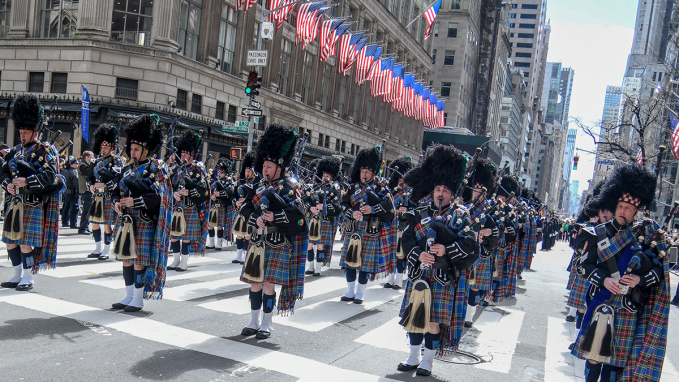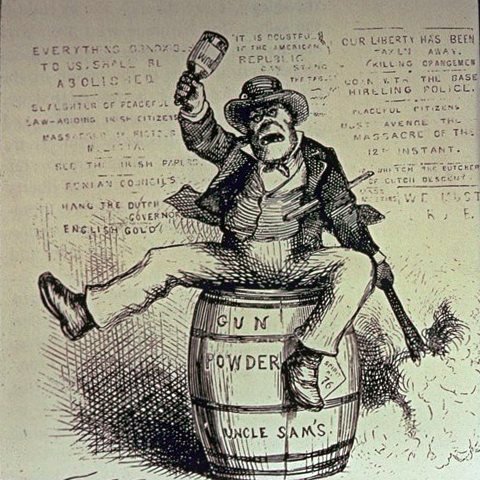Irish immigration in the United States: history and personal experiences

Everybody knows about Irish immigration in the United States and the large Irish-American community created through the centuries. It is a long history and today, two Irish expatriates in America share their stories.
The whole world knows that there is an important Irish community in the United States. Every immigrant has a story and the Irish had various reasons to move to the United States, with some reasons older than others.
Today, in a globalised world, immigration continues to happen but the reasons are changing. The American Dream continues to attract people from all around the world and the Irish are no exception.
Let’s take a look at the history of the Irish immigration to the United States before hearing from Fiona Hackett and Peter Kelly, two Irish people who crossed the ocean to emigrate and built lives for themselves on a new continent.
Why did the Irish leave for the United States?
The Irish started immigrating to America in the times of the British colonies, mostly people with Scottish or English origins who came from the province of Ulster but then fled the religious and economic conditions they found there. These immigrants were called the “Scots-Irish”.
The most famous Irish immigration was during the 1840s and 50s; a second wave of immigration associated with the famine. When people were starving in Ireland, half a million left their country to try their luck in America, accelerating the population decline on the Emerald Island.
“It is estimated that as many as 4.5 million Irish arrived in America between 1820 and 1930,” one can read on the Library of Congress’ website.
“Between 1820 and 1860, the Irish constituted over one third of all immigrants to the United States. In the 1840s, they comprised nearly half of all immigrants to this nation”.
The conditions for Irish immigrants’ weren’t always better in this new world compared to their old one: poverty; unclean, dirty conditions; and diseases were common, and this brought hostility from other ethnic groups and American citizens.
Asking why the Irish wanted to leave their country for the United States probably brings the same answers as wondering why the United States have always been so attractive for immigrants. The Irish were driven out by the difficult living conditions in Ireland, and the United States has always attracted people, benefiting from the myth surrounding it;the American Dream.
Difficulties and animosity against the Irish in the United States
Like a lot of other ethnic groups that emigrated, the Irish faced difficulties when they settled in America. Religion was a source of tensions in this country founded by the descendants of people who fled religious persecution in Europe. Some Protestants believed that these Catholics arriving in large numbers would impose Catholicism.
In an article for the website History, Christopher Klein, a writer specialising in history, quotes the book Conspiracy Theories in American History: An Encyclopedia to tell us that
“Some Protestants feared the Pope and his army would land in the United States, overthrow the government and establish a new Vatican in Cincinnati.”
The Irish were believed to spread disease and steal Americans’ jobs by accepting low-paid positions. Mass immigration also led to the creation of ghettoised communities, because large numbers of immigrants found it difficult to integrate into American society and relied on each other for support.
Political parties even emerged from the hatred towards these communities, like the Know-Nothing movement (also called Native American Party), founded in 1844 and disappearing again in 1860. It defended America as a nation based on Protestantism and believed Catholicism didn’t have a place in their society. They had some political successes, but not enough to persist.
Before the United States developed a federal emigration law system, some States had already implemented such regulations, and the Irish were often targeted. Built on former existing colonial laws, these rules allowed authorities to deport immigrants for various reasons, even after they had lived in the country for a long time.
 (Anti-Irish political cartoon titled “The Usual Irish Way of Doing Things” by Thomas Nast published in Harper’s Weekly on 2 September 1871)
(Anti-Irish political cartoon titled “The Usual Irish Way of Doing Things” by Thomas Nast published in Harper’s Weekly on 2 September 1871)
The Irish American experience
However, time passed by and things changed for Irish immigrants. Some descendents of Irish immigrants even hold, or have held, high positions in American society, like former president John Fitzgerald Kennedy, whose ancestor arrived from Ireland as a laborer in 1848.
“The refugees from the Great Hunger and the 32 million Americans with predominantly Irish roots today strengthened the United States, not destroyed it,” argues Christopher Klein.
Fiona Hackett emigrated from Dublin to Connecticut in 1992, looking for job opportunities. Peter Kelly left Trim, County Meath in 1984, going first to New York City, then Pennsylvania. Today, he lives in Florida. They both spoke to me about their experiences.
“I came on a green card visa, to family who helped with getting established”, Hackett explains.
“It was daunting and scary at the time as I had never been beyond the UK but I was 22 and took it all in my stride”. Kelly also shares various feelings when asked how he felt about his immigration: excited, scared, and sad at the same time.
But both adapted well to the American society. “It was pretty easy, since I knew some people that were here,” Kelly says. Hackett also thinks it went well, but confesses that “it took a few months to learn how things worked, transport, working situation, new types of food…”.
Neither of them faced problems when they arrived in the United States. Kelly mentions “a few people with attitudes, but mostly very welcoming”. Hackett says that she “moved to an Irish-friendly community”, adding that “Irish people are very well thought of in New York”. Fortunately for them, the time when Irish people had a bad reputation in America had long passed.
“There are plenty of Irish communities,” Kelly adds, explaining that he knew a lot of Irish people because his brothers and some friends from his hometown were already in America. “I know less [people with Irish origins] now, as I live outside of New York,” Hackett says. “But we’re involved in an Irish club in our town, we play Gaelic football, and have a good network of Irish connections.”
The Irish community has a good reputation in the U.S, but Hackett regrets the fact that the culture is “a little stagnant now”, especially outside of big cities. “The Irish are very close knit, help each other out, and stick together”, Kelly comments when he’s asked about his opinion on the Irish community.
However, Irish people still face some clichés in the United States, like anywhere else, and like every ethnic group. “People still see the Irish in the stereotypes of drinkers and laborers,” Hackett says. Kelly mentions the same ideas, but also talks about the reputation of the Irish as friendly, nice, kind, and respectful people.
 (Irish Immigrants, by Mike Maguire)
(Irish Immigrants, by Mike Maguire)
Emigrating is not always easy, and if Kelly confesses that he misses Ireland and his friends and family, Hackett says she doesn’t really feel homesick. “I moved back for a year in 2016 but couldn’t settle, I found Ireland had hardly changed since 1992 and we moved back to the U.S in 2017.” However, she also mentions missing being around her family, the food, and the social scene.
Hackett qualifies Ireland as “very slow-moving” but she explains that it can be positive: “You’re forced to slow down and there is a lot less stress.” Comparing the two countries she has lived in, she says that “people have similar mindsets, it can be a good and a bad thing.”
Kelly agrees on the similarities: “America is just bigger, but both places are easy to adjust to and both are great countries.”
Hackett and Kelly don’t have a very different opinion on a possible return in Ireland. “Maybe in retirement for part of the year,” Hackett answers when she was asked if she could move back. Kelly answers with a firm yes, “it’s in the plans to do both six months in Ireland and six months in America”.
Irish immigration in the United States is older than the country itself. In a globalized world, it is not surprising to hear about easy adaptation in another English-speaking country. Either to flee a situation or just to look for new horizons, people have always been crossing continents and oceans to build a life in another country, and will keep doing it.
And you, did you know about the history of Irish immigration in the U.S? Let us know in the comment section!
Attribution to : Sean Rowe, licence: Attribution-NonCommercial-NoDerivs 2.0 Generic (CC BY-NC-ND 2.0)
 (
(